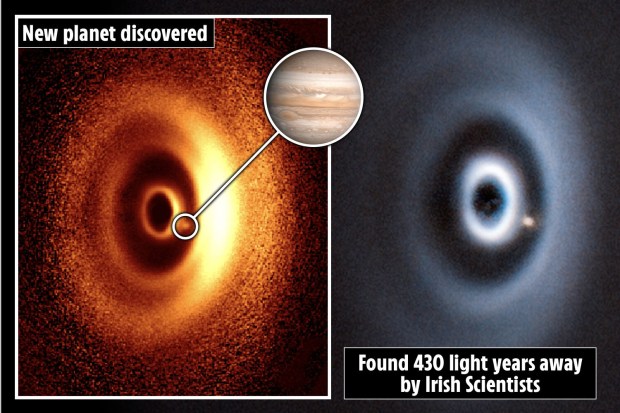Science
Irish Astronomers Discover New Planet WISPIT 2b, 430 Light-Years Away

Irish astronomers have made a significant breakthrough in astronomy with the discovery of a new planet, named WISPIT 2b, located approximately 430 light-years away from Earth. This planet, believed to be around five million years old, is likely a gas giant similar in size to Jupiter. The findings were published in the Astrophysical Journal Letters and were part of an international study co-led by researchers from the University of Galway, Leiden University, and the University of Arizona.
The planet was detected in a formative stage around a young star that shares characteristics with our Sun. The groundbreaking observations were conducted using the European Southern Observatory’s Very Large Telescope (ESO’s VLT) situated in the Atacama Desert, Chile.
Dr. Christian Ginski, a lecturer at the School of Natural Sciences at the University of Galway and one of the study’s authors, explained the innovative approach used to discover the planet. “We utilized brief snapshot observations of numerous young stars—only a few minutes per object—to ascertain if we could detect a small dot of light next to them, indicating a planet,” he said.
During the observation, the team detected a remarkable multi-ringed dust disk surrounding the star. Upon this discovery, follow-up observations were promptly requested to investigate further.
Significance of WISPIT 2b in Planetary Research
WISPIT 2b is only the second confirmed planet detected at such an early evolutionary stage around a young star resembling our Sun. The first instance of this phenomenon occurred in 2018, also involving Dr. Ginski. The planet was captured in near-infrared light, which is akin to the view one would see through night-vision goggles, as it remains warm from its formation phase.
A clear image of the young proto-planet embedded in a disk gap was captured by the team, confirming that WISPIT 2b orbits its host star. The planet is still actively accumulating gas, which is essential for the formation of its atmosphere. Dust and gas-rich disks like the one surrounding WISPIT 2b are known as the birthplaces of planets and exhibit various structures, including rings and spiral arms, linked to ongoing planetary formation.
The disk surrounding WISPIT 2b has a radius of 380 astronomical units, roughly 380 times the distance from Earth to the Sun.
A Collaborative Effort in Astronomy
The research was spearheaded by early-career PhD student Richelle van Capelleveen from Leiden University, with collaboration from a team of graduate students at the University of Galway. Van Capelleveen expressed her enthusiasm, stating, “Discovering this planet was an amazing experience—we were incredibly lucky.”
Chloe Lawlor, another PhD student at the University of Galway specializing in astrophysics, shared her perspective on the discovery. “I feel incredibly fortunate to be involved in such an exciting and potentially career-defining discovery,” she said. “WISPIT 2b is a beautiful example of a planet that can be used to explore current planet formation models.”
Jake Byrne, an MSc student at the University of Galway, remarked on the impactful nature of the discovery, saying, “I could hardly believe it was a real detection when I first saw the image of this remarkable discovery.”
Such collaborative efforts highlight the significant strides being made in our understanding of how planets form and evolve. The discovery of WISPIT 2b is poised to enhance discussions within the research community and contribute to the advancement of planetary formation theories.
Dan McLachlan, also an MSc student at the University of Galway, noted the excitement within the department and expressed gratitude for the opportunity to participate in the project.
The discovery of WISPIT 2b marks a notable milestone in contemporary astronomy, showcasing the capabilities of modern observational technology and the collaborative spirit of researchers across institutions.
-

 Entertainment4 weeks ago
Entertainment4 weeks agoAimee Osbourne Joins Family for Emotional Tribute to Ozzy
-

 Politics1 month ago
Politics1 month agoDanny Healy-Rae Considers Complaint After Altercation with Garda
-

 Top Stories2 weeks ago
Top Stories2 weeks agoIreland Enjoys Summer Heat as Hurricane Erin Approaches Atlantic
-

 World1 month ago
World1 month agoHawaii Commemorates 80 Years Since Hiroshima Bombing with Ceremony
-

 Top Stories1 month ago
Top Stories1 month agoFianna Fáil TDs Urgently Consider Maire Geoghegan-Quinn for Presidency
-

 World1 month ago
World1 month agoGaza Aid Distribution Tragedy: 20 Killed Amid Ongoing Violence
-

 World1 month ago
World1 month agoCouple Convicted of Murdering Two-Year-Old Grandson in Wales
-

 Top Stories1 month ago
Top Stories1 month agoClashes Erupt Between Far-Right Groups and Migrants in Spain
-

 World1 month ago
World1 month agoAristocrat Constance Marten and Partner Convicted of Infant Murder
-

 Top Stories1 month ago
Top Stories1 month agoHistoric Dalkey Pub The Queens Reopens Under New Management
-

 World1 month ago
World1 month agoTrump Defends FBI Deputy Director Amid Epstein Files Controversy
-

 Politics1 month ago
Politics1 month agoTragic Crowd Surge at Gaza Aid Center Claims 20 Lives









